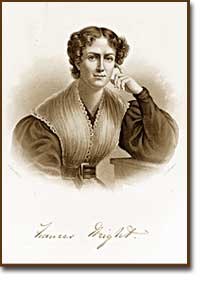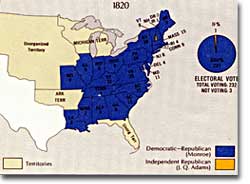23b. The Expansion of the Vote: A White Man's Democracy

Frances Wright visited the U.S. from Europe. She wrote of the new American Republic: "Women are assuming their place as thinking beings, not in despite of the men, but chiefly in consequence of their enlarged views and exertions as fathers and legislators."
The rise of political parties as the fundamental organizing unit of the Second (Two) Party System represented a sharp break from the values that had shaped Republican and Federalist political competition. Leaders in the earlier system remained deeply suspicious that parties could corrupt and destroy the young republic. At the heart of the new legitimacy of parties, and their forthright celebration of democracy, was the dramatic expansion of voting rights for white men.
Immediately after the Revolution most states retained some property requirements that prevented poor people from voting. Following republican logic, citizens were believed to need an economic stake in society in order to be trusted to vote wisely. If a voter lacked economic independence, then it seemed that those who controlled his livelihood could easily manipulate his vote.
Ironically, just as industrial wage labor began to create dependent laborers on a large new scale, the older republican commitment to propertied voters fell out of favor. As property requirements for voting were abolished, economic status disappeared as a foundation for citizenship. By 1840 more than 90 percent of adult white men possessed the right to vote.
Not only that, voters could now cast their opinion for more offices. Previously, governors and presidential electors had usually been selected by state legislatures as part of a republican strategy that limited the threat of direct democratic control over the highest political offices. The growing democratic temper of the first decades of the 19th century changed this and increasingly all offices were chosen by direct vote. The United States was the world leader in allowing popular participation in elections. This triumph of American politics built upon, but also expanded, the egalitarian ideals of the American Revolution.
This democratic triumph, however, also had sharp limitations that today seem quite shocking. At the same time that state legislatures opened suffrage (that is, the right to vote) to all white men, they simultaneously closed the door firmly on white women and free African Americans. This movement was especially disappointing since it represented a retreat from a broader sense of political rights that had been included in some early state constitutions.

James Monroe nearly shut out his Presidential opponent, John Quincy Adams in the election of 1820. Monroe beat Adams 231 to 1 with 3 abstentions (electoral college votes).
For example, New Jersey revised its state constitution to abolish property requirements in 1807, but at the same time prevented all women from voting (even wealthy ones who had been allowed to vote there since 1776) as well as all free blacks. New York acted similarly in 1821 when its legislature extended the franchise to almost all white men, but simultaneously created high property requirements for free blacks. As a result, only 68 of the 13,000 free African Americans in New York City could vote in 1825. When Pennsylvania likewise denied free blacks the right to vote in the late 1830s, a state legislator explained that "The people of this state are for continuing this commonwealth, what it has always been, a political community of white persons." While he was correct about the prevailing racist sentiment among white voters, free blacks with property had not been excluded from the franchise by the earlier Revolutionary state constitution.
Tragically, the democratization of American politics to include nearly universal white manhood suffrage also intensified discrimination by race and gender. The idea of total democracy remained too radical for full implementation.






